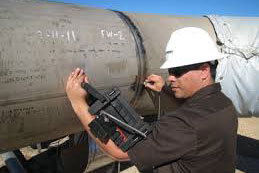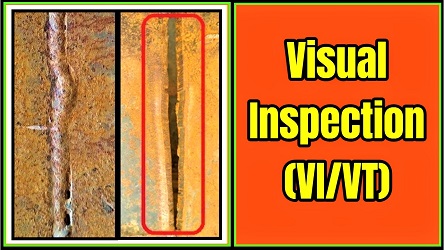Reputable Welding Inspection Gilbert Arizona: Trick Factors to Take Into Consideration for Ideal Outcomes
A Comprehensive Overview to Welding Inspection: Recognizing Criteria, Techniques, and Ideal Practices for Quality Control

Welding inspection plays a crucial function in guaranteeing the architectural stability and safety of bonded components, demanding a detailed understanding of market standards such as those developed by AWS and ASME. As we check out these critical aspects, it becomes noticeable that the ramifications of welding evaluation extend much beyond conformity, inviting a closer examination of just how these processes shape industry standards and techniques.
Significance of Welding Examination
Welding assessment plays an important role in making sure the integrity and security of welded structures. It is a crucial procedure that verifies that welds conform to predefined requirements, which is important in numerous industries, consisting of building, auto, and aerospace. By conducting thorough assessments, potential flaws such as fractures, incomplete fusion, and porosity can be determined early, avoiding catastrophic failures that could cause accidents or expensive repair work.
The relevance of welding inspection prolongs past plain compliance with laws; it also fosters count on with stakeholders. Customers and regulatory bodies expect assurance that the structures they depend on are constructed to hold up against operational tensions. Effective welding inspection methods add to lasting resilience and performance of the frameworks, inevitably leading to decreased maintenance costs.
Additionally, welding evaluation promotes a culture of high quality within companies, motivating adherence to ideal techniques and continual renovation. By integrating evaluation processes into the welding process, business can improve their track record and establish themselves as leaders in quality guarantee. In verdict, the relevance of welding assessment lies in its capacity to secure lives, make sure structural integrity, and maintain industry criteria, making it an indispensable aspect of welding procedures.
Key Industry Requirements
Making sure compliance with crucial industry requirements is vital for preserving the quality and security of bonded frameworks. Various companies establish these standards to advertise best techniques in welding and inspection. Among one of the most recognized are the American Welding Culture (AWS) and the American Culture of Mechanical Designers (ASME), which supply detailed guidelines and requirements for welding procedures and evaluation requirements.
AWS criteria, such as AWS D1.1 for structural welding, summary needs for products, design, and testing to make sure the honesty of welds. Similarly, ASME codes, including ASME Area IX, control the qualification of welders and welding procedures, making sure regular quality in industrial applications. Internationally, the ISO 3834 conventional highlights top quality needs for blend welding, providing a framework for organizations to show compliance with global finest methods.
Conformity with these standards not just boosts the dependability of bonded frameworks but likewise mitigates risks associated with structural failings. Furthermore, adherence to industry requirements is usually a prerequisite for regulative approvals and can substantially influence job requirements. Ultimately, understanding and executing these key standards are important for reliable welding inspection and high quality assurance.
Evaluation Techniques Summary
Effective welding examination relies upon a range of strategies designed to analyze the high quality and integrity of welds. These strategies can be extensively categorized right into non-destructive and destructive screening (NDT) techniques. Non-destructive screening methods, which are extensively liked in the market, permit for the examination of welds without compromising the honesty of the material.
Amongst the most generally utilized NDT techniques are aesthetic inspection, ultrasonic screening, radiographic testing, and magnetic bit screening. my company Visual inspection is usually the very first step in the examination process, making it possible for examiners to identify surface area imperfections and analyze weld grain profiles. Ultrasonic screening utilizes high-frequency acoustic waves to discover interior imperfections and gauge the thickness of welds. Radiographic screening entails making use of X-ray or gamma-ray imaging to expose inner defects, while magnetic bit screening is reliable for discovering surface area and near-surface suspensions in ferromagnetic materials.
Each strategy has its very own advantages and limitations, making it vital for assessors to pick the most appropriate method based on the particular demands of the job, the products involved, and the criticality of the welds being examined. This careful selection guarantees detailed analyses and maintains safety and quality criteria in welding procedures.

Common Problems and Their Ramifications
A Find Out More complete understanding of usual defects in welds is essential for preserving structural stability and safety and security in bonded building and constructions. Welding defects can considerably compromise the mechanical buildings of the joint, leading to failures that can jeopardize both employees and devices.
Typical problems include porosity, which shows up as tiny gas pockets caught in the weld metal, weakening the overall framework. Fracturing is an additional common issue, usually arising from fast cooling or incorrect joint style, causing stress concentrations that can lead to tragic failings. Incomplete combination occurs when the weld steel stops working to effectively bond with the base material, producing weak factors that may bring about separation under lots.
Other remarkable defects consist of damaging, where the weld bead erodes the base metal, and slag additions, which can hinder the weld's strength. Each of these issues has details ramifications; for example, porosity can reduce ductility, while splitting directly influences tensile stamina. Identifying and recognizing these issues throughout examination is essential for applying restorative steps and ensuring compliance with market criteria, ultimately protecting the architectural integrity of bonded settings up.
Finest Practices for Top Quality Assurance
Carrying out best techniques for quality control in welding processes is crucial for achieving ideal results and lessening defects. One crucial practice is the establishment of clear welding procedures that follow sector criteria and requirements. These procedures should include thorough guidelines relating to material option, joint prep work, and welding strategies to guarantee consistency and top quality.
Regular training and accreditation of welding workers are likewise vital. Proficient welders that understand the importance of quality control are most likely to produce audio welds. Additionally, implementing a durable assessment program, consisting see of both non-destructive and aesthetic testing (NDT), can help identify issues early at the same time, permitting timely corrective actions.
Paperwork plays a key function in quality control. Maintaining precise records of welding examinations, specifications, and repair services makes certain traceability and liability. In addition, employing advanced innovations such as automated welding machines can enhance accuracy and minimize the possibility for human error - Welding Inspection Gilbert Arizona.
Finally, cultivating a society of quality within the company encourages workers to focus on quality in their job. By adhering to these finest methods, organizations can enhance the integrity of their welding procedures, eventually bring about improved product high quality and decreased expenses linked with rework and repair services.

Verdict
In final thought, welding evaluation plays an important function in making certain the integrity and security of welded frameworks. By executing best techniques, organizations can improve reliability, reduce upkeep costs, and grow trust amongst clients, eventually contributing to successful welding procedures.
Furthermore, welding inspection promotes a society of quality within companies, motivating adherence to finest practices and continual improvement. In verdict, the importance of welding assessment exists in its ability to safeguard lives, guarantee structural integrity, and copyright sector criteria, making it an essential aspect of welding procedures.
Amongst the most recognized are the American Welding Society (AWS) and the American Culture of Mechanical Engineers (ASME), which offer thorough standards and requirements for welding procedures and assessment standards.
Inevitably, understanding and applying these essential standards are crucial for effective welding inspection and quality guarantee.
Efficient welding inspection depends on a selection of techniques created to evaluate the high quality and integrity of welds. - Welding Inspection Gilbert Arizona